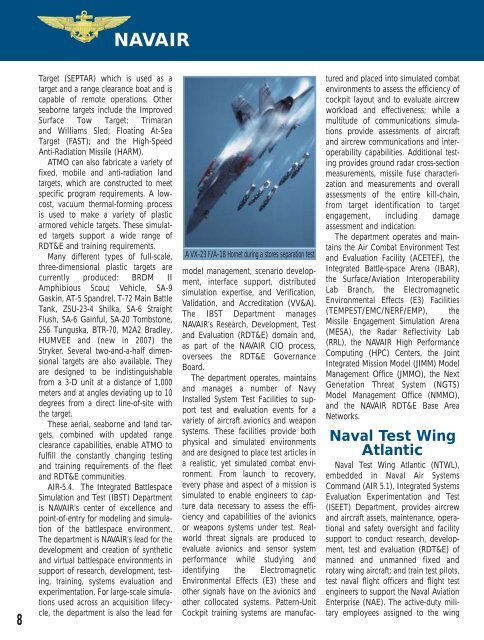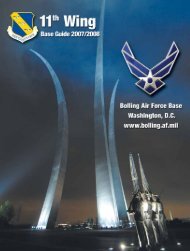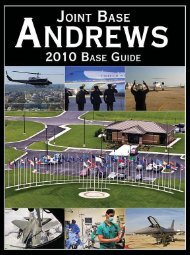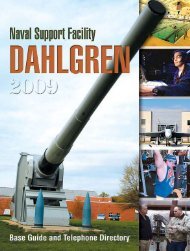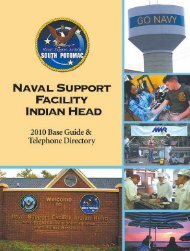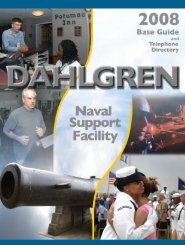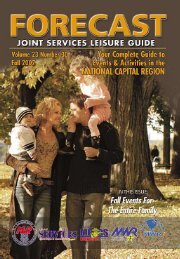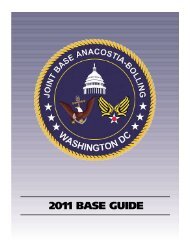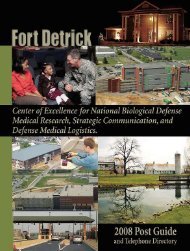About Naval Air Station Patuxent River - DCMilitary.com
About Naval Air Station Patuxent River - DCMilitary.com
About Naval Air Station Patuxent River - DCMilitary.com
Create successful ePaper yourself
Turn your PDF publications into a flip-book with our unique Google optimized e-Paper software.
8<br />
NAVAIR<br />
Target (SEPTAR) which is used as a<br />
target and a range clearance boat and is<br />
capable of remote operations. Other<br />
seaborne targets include the Improved<br />
Surface Tow Target; Trimaran<br />
and Williams Sled; Floating At-Sea<br />
Target (FAST); and the High-Speed<br />
Anti-Radiation Missile (HARM).<br />
ATMO can also fabricate a variety of<br />
fixed, mobile and anti-radiation land<br />
targets, which are constructed to meet<br />
specific program requirements. A lowcost,<br />
vacuum thermal-forming process<br />
is used to make a variety of plastic<br />
armored vehicle targets. These simulated<br />
targets support a wide range of<br />
RDT&E and training requirements.<br />
Many different types of full-scale,<br />
three-dimensional plastic targets are<br />
currently produced: BRDM II<br />
Amphibious Scout Vehicle, SA-9<br />
Gaskin, AT-5 Spandrel, T-72 Main Battle<br />
Tank, ZSU-23-4 Shilka, SA-6 Straight<br />
Flush, SA-6 Gainful, SA-20 Tombstone,<br />
2S6 Tunguska, BTR-70, M2A2 Bradley,<br />
HUMVEE and (new in 2007) the<br />
Stryker. Several two-and-a-half dimensional<br />
targets are also available. They<br />
are designed to be indistinguishable<br />
from a 3-D unit at a distance of 1,000<br />
meters and at angles deviating up to 10<br />
degrees from a direct line-of-site with<br />
the target.<br />
These aerial, seaborne and land targets,<br />
<strong>com</strong>bined with updated range<br />
clearance capabilities, enable ATMO to<br />
fulfill the constantly changing testing<br />
and training requirements of the fleet<br />
and RDT&E <strong>com</strong>munities.<br />
AIR-5.4. The Integrated Battlespace<br />
Simulation and Test (IBST) Department<br />
is NAVAIR’s center of excellence and<br />
point-of-entry for modeling and simulation<br />
of the battlespace environment.<br />
The department is NAVAIR’s lead for the<br />
development and creation of synthetic<br />
and virtual battlespace environments in<br />
support of research, development, testing,<br />
training, systems evaluation and<br />
experimentation. For large-scale simulations<br />
used across an acquisition lifecycle,<br />
the department is also the lead for<br />
A VX-23 F/A-18 Hornet during a stores separation test<br />
model management, scenario development,<br />
interface support, distributed<br />
simulation expertise, and Verification,<br />
Validation, and Accreditation (VV&A).<br />
The IBST Department manages<br />
NAVAIR’s Research, Development, Test<br />
and Evaluation (RDT&E) domain and,<br />
as part of the NAVAIR CIO process,<br />
oversees the RDT&E Governance<br />
Board.<br />
The department operates, maintains<br />
and manages a number of Navy<br />
Installed System Test Facilities to support<br />
test and evaluation events for a<br />
variety of aircraft avionics and weapon<br />
systems. These facilities provide both<br />
physical and simulated environments<br />
and are designed to place test articles in<br />
a realistic, yet simulated <strong>com</strong>bat environment.<br />
From launch to recovery,<br />
every phase and aspect of a mission is<br />
simulated to enable engineers to capture<br />
data necessary to assess the efficiency<br />
and capabilities of the avionics<br />
or weapons systems under test. Realworld<br />
threat signals are produced to<br />
evaluate avionics and sensor system<br />
performance while studying and<br />
identifying the Electromagnetic<br />
Environmental Effects (E3) these and<br />
other signals have on the avionics and<br />
other collocated systems. Pattern-Unit<br />
Cockpit training systems are manufac-<br />
tured and placed into simulated <strong>com</strong>bat<br />
environments to assess the efficiency of<br />
cockpit layout and to evaluate aircrew<br />
workload and effectiveness; while a<br />
multitude of <strong>com</strong>munications simulations<br />
provide assessments of aircraft<br />
and aircrew <strong>com</strong>munications and interoperability<br />
capabilities. Additional testing<br />
provides ground radar cross-section<br />
measurements, missile fuse characterization<br />
and measurements and overall<br />
assessments of the entire kill-chain,<br />
from target identification to target<br />
engagement, including damage<br />
assessment and indication.<br />
The department operates and maintains<br />
the <strong>Air</strong> Combat Environment Test<br />
and Evaluation Facility (ACETEF), the<br />
Integrated Battle-space Arena (IBAR),<br />
the Surface/Aviation Interoperability<br />
Lab Branch, the Electromagnetic<br />
Environmental Effects (E3) Facilities<br />
(TEMPEST/EMC/NERF/EMP), the<br />
Missile Engagement Simulation Arena<br />
(MESA), the Radar Reflectivity Lab<br />
(RRL), the NAVAIR High Performance<br />
Computing (HPC) Centers, the Joint<br />
Integrated Mission Model (JIMM) Model<br />
Management Office (JMMO), the Next<br />
Generation Threat System (NGTS)<br />
Model Management Office (NMMO),<br />
and the NAVAIR RDT&E Base Area<br />
Networks.<br />
<strong>Naval</strong> Test Wing<br />
Atlantic<br />
<strong>Naval</strong> Test Wing Atlantic (NTWL),<br />
embedded in <strong>Naval</strong> <strong>Air</strong> Systems<br />
Command (AIR 5.1), Integrated Systems<br />
Evaluation Experimentation and Test<br />
(ISEET) Department, provides aircrew<br />
and aircraft assets, maintenance, operational<br />
and safety oversight and facility<br />
support to conduct research, development,<br />
test and evaluation (RDT&E) of<br />
manned and unmanned fixed and<br />
rotary wing aircraft; and train test pilots,<br />
test naval flight officers and flight test<br />
engineers to support the <strong>Naval</strong> Aviation<br />
Enterprise (NAE). The active-duty military<br />
employees assigned to the wing


